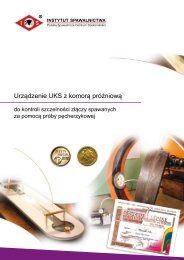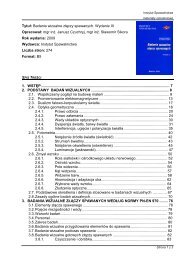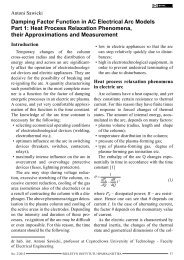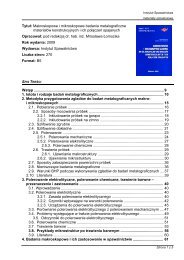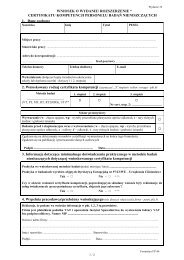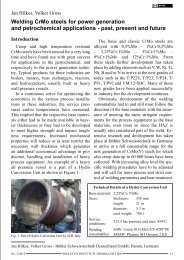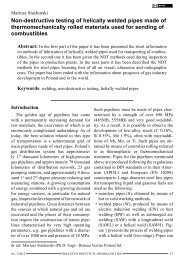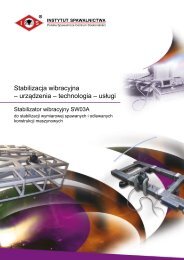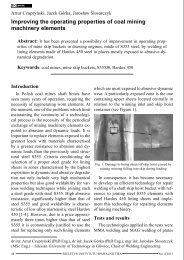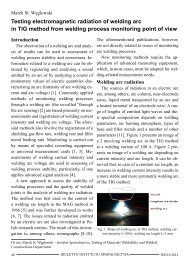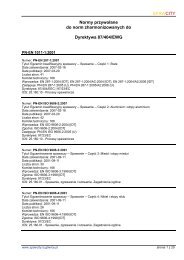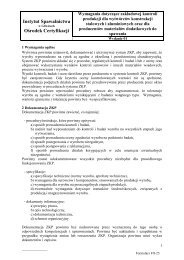Biuletyn Instytutu Spawalnictwa No. 01/2012
Biuletyn Instytutu Spawalnictwa No. 01/2012
Biuletyn Instytutu Spawalnictwa No. 01/2012
Create successful ePaper yourself
Turn your PDF publications into a flip-book with our unique Google optimized e-Paper software.
1 dr<br />
r dt<br />
- in the resistance form<br />
1 ⎛ u<br />
⎜1<br />
−<br />
⎝ U<br />
2<br />
=<br />
kol<br />
2<br />
θC<br />
C<br />
⎞<br />
⎟<br />
⎠<br />
(3)<br />
where ϴ C<br />
– time constant of the model, U C<br />
–<br />
model voltage, g = 1/r – conductance and resistance<br />
of the arc column.<br />
Similarly, on the basis of the power balance<br />
equation (1) and after adopting appropriate<br />
simplifying assumptions and transformations<br />
[3], one can obtain the Mayr-Kulakov models<br />
in the conductance form<br />
1<br />
g<br />
dg<br />
dt<br />
1 ⎛ u ⎞<br />
koli<br />
= ⎜ −1<br />
⎟<br />
θM<br />
⎝ PM<br />
⎠<br />
or in the resistance form<br />
1<br />
r<br />
dr<br />
dt<br />
1 ⎛ u<br />
⎜1<br />
−<br />
⎝ P<br />
=<br />
kol<br />
θM<br />
M<br />
i ⎞<br />
⎟<br />
⎠<br />
(4)<br />
(5)<br />
where U stat<br />
(i) – static voltage-current characteristics,<br />
G stat<br />
(i) – static nonlinear conductance,<br />
R(3)<br />
stat<br />
(i) – static nonlinear resistance.<br />
After substituting (8) and (9) to (6) and (7)<br />
one obtains a generalised Mayr-Kulakov equation<br />
in the conductance form<br />
1 dg 1 ⎡Gstat<br />
() i ⎤<br />
= ⎢ −1<br />
g dt θ<br />
⎥<br />
(10)<br />
Ms ⎣ g ⎦<br />
or in the resistance form<br />
1<br />
r<br />
(11)<br />
(4) When conductance does not change in time,<br />
the static characteristics of the arc in this model<br />
are as follows:<br />
U<br />
(5)<br />
dr<br />
dt<br />
1 ⎡ r<br />
() ⎥ ⎤<br />
= ⎢1<br />
−<br />
θ<br />
Ms ⎣ Rstat<br />
i ⎦<br />
() i<br />
stat<br />
=<br />
P<br />
i<br />
M<br />
(12)<br />
(1<br />
(<br />
where ϴ M<br />
– time constant of the model, P M<br />
–<br />
power of Mayr-Kulakov model.<br />
The Mayr-Kulakov arc model can be transformed<br />
into another, general conductance form<br />
1<br />
g<br />
dg<br />
dt<br />
() t<br />
1 ⎡ P<br />
() ⎥ ⎥ ⎤<br />
kol<br />
= ⎢ −1<br />
θ Ms ⎢⎣<br />
Pdys<br />
t ⎦<br />
or the resistance form<br />
(6)<br />
(13)<br />
Therefore, on the basis of these formulas<br />
one can write models (6) and (7) in the conductance<br />
form<br />
(6)<br />
1 dg 1 ⎡ i ⎤<br />
= ⎢ −1⎥ g dt θ Ms ⎣ g ⋅U<br />
stat<br />
() i ⎦<br />
1 dr 1 ⎡ P () ⎤<br />
or in the resistance form<br />
= ⎢ −<br />
kol<br />
t<br />
1 ⎥<br />
(7) (7)<br />
r dt θ<br />
Ms ⎢⎣<br />
Pdys<br />
() t ⎥ ⎦<br />
1 dr 1 ⎡ ri<br />
()<br />
where ϴ Ms<br />
– corresponds to relaxation time of<br />
⎥ ⎤<br />
= ⎢1<br />
−<br />
(15)<br />
r dt θ<br />
Ms ⎣ U<br />
stat<br />
i ⎦<br />
thermal process, and the supplied electric power<br />
amounts to<br />
U stat<br />
(i) = - U stat<br />
(-i).<br />
The application of the appropriate approximation<br />
of static characteristic U<br />
2<br />
i 2<br />
P<br />
(8)<br />
stat<br />
(i) offers more<br />
kol<br />
() t = ukoli<br />
= = i r<br />
(8)<br />
g<br />
precise determination of arc dynamic characteristics<br />
if compared with hyperbolic static characteristic,<br />
pre-set only by one constant Mayr-Ku-<br />
As the processes of heat dissipation slowly<br />
respond to external disturbance, one can assume<br />
that the power of losses is basically deterlakov<br />
power value. Such an approach extends<br />
somewhat the range of the model applicability to<br />
mined by static characteristics [4] i.e. include stronger currents, when a characteristic<br />
2<br />
i 2<br />
P () t U () i i i R () i<br />
is no longer drooping [5] but becomes flat and, in<br />
dys<br />
=<br />
stat<br />
⋅ = =<br />
stat<br />
()<br />
(9)<br />
(9)<br />
Gstat<br />
i<br />
the case of stronger currents, is even rising.<br />
G<br />
stat<br />
() i<br />
i<br />
=<br />
P<br />
2<br />
M<br />
=<br />
U<br />
i<br />
stat<br />
2<br />
=<br />
1<br />
() i ⋅i<br />
R () i<br />
stat<br />
(14)<br />
(<br />
NR <strong>01</strong>/2<strong>01</strong>2<br />
BIULETYN INSTYTUTU SPAWALNICTWA<br />
17



